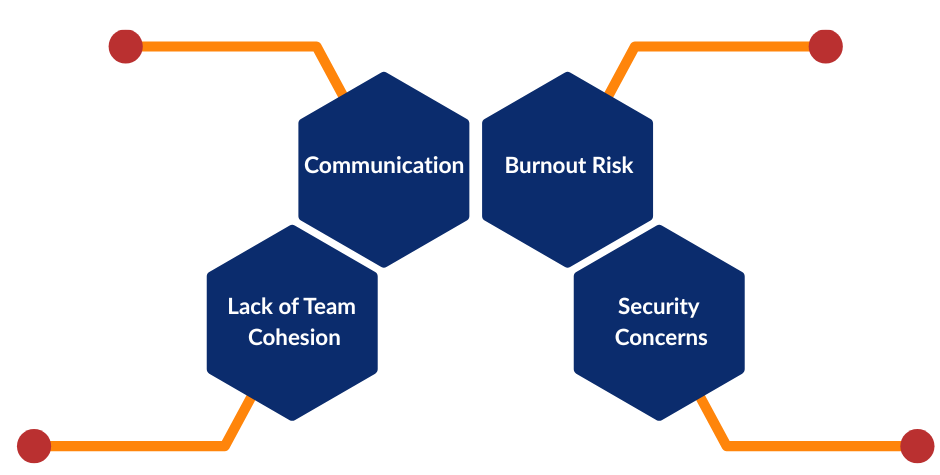
Remote work is no longer the future, it’s the present. Software companies and startups worldwide are increasingly adopting distributed team models to stay competitive, access global talent, and scale faster. Yet, managing a remote software development team comes with its own set of challenges: missed deadlines, communication gaps, difficulties in building trust, and even data security concerns.
At the same time, the advantages are too significant to overlook. Companies that embrace distributed teams report improved productivity, higher retention, and access to top-tier developers across regions. According to Buffer’s State of Remote Work 2023, 98% of workers want to work remotely at least part of the time, making it clear that remote work is here to stay.
If your internal team is already stretched thin, here’s how to scale without burning out your developers.
This article explores 10 proven strategies to manage a remote software development team effectively, from onboarding and team engagement to data security and automation.
Why Hire Remote Developers?

Hiring remote developers allows companies to expand beyond geographical limits and access specialized skills without long recruitment cycles. Some of the key benefits include:
Quick scalability with lower risks – Remote teams make it easy to ramp up resources for a project without committing to long-term headcount.
Access to skilled talent pools – Companies can bring in highly experienced developers who seamlessly integrate into existing teams or work independently.
Higher retention rates – Remote developers often enjoy improved work-life balance, leading to greater job satisfaction and loyalty.
Flexibility and adaptability – Businesses can scale teams up or down depending on project requirements, reducing overhead costs.
For many startups and mid-sized businesses, this flexibility and cost-effectiveness make remote hiring a cornerstone of growth.
Countries like Egypt have become recognized tech hubs, offering a rich pool of skilled developers at competitive costs. With a strong cultural fit and proximity to Europe, Egyptian teams integrate smoothly with international companies. Read more in our article: Egypt’s Rise as a Global Technology and Outsourcing Hub
What Challenges Arise When Managing Remote Teams?

While the benefits are clear, managing remote software teams comes with hurdles that must be addressed to avoid inefficiencies:
Asynchronous communication – Different time zones can lead to delays or misaligned priorities.
Lack of team cohesion – Remote developers may feel isolated without deliberate engagement efforts.
Burnout risk – Adjusting schedules to overlap with global teams can cause irregular hours.
Security concerns – Sensitive project data needs stronger safeguards when accessed remotely.
Understanding these challenges is the first step in overcoming them. Working with established partners like Pharos Solutions helps overcome these challenges, combining 14 years of experience, proven security practices, and a track record of scaling remote teams for European companies. Learn more: Bridging Continents with Code: What It Means to Be a German-Egyptian Tech Company
10 Proven Strategies to Manage a Remote Software Development Team Effectively
1. Get Onboarding Right From Day One
The foundation of a successful remote collaboration lies in well-structured onboarding. Before integrating remote developers:
Assess team readiness – Understand existing workflows, cultural fit, and tools already in place.
Plan structured onboarding – Provide technical documentation, role expectations, and access to tools before day one.
Cultural integration matters – Organize virtual introductions and emphasize how remote members contribute to the big picture.
Proactive preparation – Grant tool access, share guidelines, and prepare credentials in advance to avoid a slow start.
Example: If you’re extending your in-house team with dedicated developers, consider pairing them with internal “buddies” to ease integration.
2. Keep Your Remote Team Engaged and Motivated
A motivated remote team is a productive one. Engagement strategies include:
Clear objectives – Set measurable goals and communicate responsibilities transparently.
Learning opportunities – Offer access to online training, workshops, or mentorship programs.
Recognition and rewards – Celebrate achievements with public acknowledgment or incentives.
Virtual team-building – From online game nights to brainstorming sessions, small gestures create big bonds.
When developers feel connected to the mission and appreciated, they are more invested in outcomes.
3. Maintain Momentum with Clear Goals
To maintain productivity, set clear goals, key performance indicators (KPIs), milestones, and deadlines. Regularly communicate progress and provide feedback to keep everyone aligned.
One of the fastest ways to create confusion in a remote setup is unclear ownership. Developers need to know who’s responsible for what, and managers need to align priorities. For startups, especially, it’s important to balance between hiring internally and extending your team externally. Here’s a deeper look at Outstaffing vs. In-House Hiring
Other tips:
- Break down larger projects into smaller, actionable tasks.
- Conduct routine performance assessments.
- Offer support and resources to address roadblocks.
- Tackle underperformance with open dialogue and support plans.
4. Secure Your Remote Setup Before It Breaks
Data security is one of the top concerns when managing remote developers. To mitigate risks:
Train the team on data security protocols and best practices.
Use secure collaboration tools with encryption and access control.
Audit remote access regularly to monitor suspicious activity.
Keep all systems up to date with the latest security patches.
With regulations like GDPR in Europe, ensuring compliance isn’t optional; it’s essential.
5. Evolve Practices for Remote Success
Remote management is never “set it and forget it.” Teams need to continuously refine practices.
Regular reviews – Evaluate what works and what doesn’t.
Adopt an agile mindset – Flexibility is key to long-term remote success.
Encourage open feedback – Create safe spaces where developers can voice suggestions.
Small iterative improvements often lead to significant performance gains.
6. Involve Everyone in User Testing
User testing becomes stronger when it’s inclusive. Developers, testers, and designers all bring unique perspectives to evaluating user experience.
Run collaborative testing sessions where team members review functionality together.
Gather cross-functional insights to refine features more effectively.
Use feedback loops to continuously improve user satisfaction.
This practice strengthens accountability and ensures the product truly aligns with user expectations.
7. Embrace Change in the Digital Transformation Era
Remote work is part of a broader digital transformation. Successful teams:
Stay updated on emerging tools (AI-assisted coding, DevOps automation, etc.).
Encourage continuous learning through certifications and workshops.
Promote a culture of adaptability, experiment with new practices, and keep what works.
By embracing change, teams remain competitive and future-ready.
8. Resolve Issues Quickly with Technology
Conflicts or issues are inevitable, especially in distributed settings. What matters is how they’re addressed:
Use video calls for sensitive discussions to reduce misunderstandings.
Leverage mediation tools for structured conflict resolution.
Encourage open communication so problems surface early, not after deadlines slip.
Prompt resolution maintains trust and prevents disruption.
9. Automate for Productivity
Repetitive manual tasks slow teams down. Automating workflows creates more space for innovation.
Automate testing, deployments, and CI/CD pipelines to reduce errors.
Use bots or scripts for repetitive administrative tasks.
Free developers’ time for value-adding work like problem-solving and innovation.
Automation also improves consistency, speeding up time-to-market.
10. Build Partnerships, Not Just Projects
Remote team management isn’t only about processes, it’s about building lasting relationships. Teams that understand the client’s business context deliver better results.
Share the “why” behind the project, not just the task list.
Encourage knowledge sharing across teams and projects.
Build a culture of trust and ownership where remote developers feel part of the mission.
Conclusion
Managing a remote software development team successfully isn’t just about processes and tools. It’s about building trust, fostering collaboration, and creating an environment where developers feel connected to the mission, no matter where they sit.
The most effective teams go beyond task delivery. They share knowledge, stay adaptable, and align with the client’s bigger picture. At Pharos Solutions, we specialize in helping businesses scale quickly with dedicated teams, staff augmentation, and remote teams. Our identity as a German-Egyptian tech company helps us bridge expectations and cultures, making remote collaboration feel seamless. Learn more: Bridging the Cultural Gap: Uniting German and Egyptian Cultures
If you’re looking to build or scale a high-performing remote development team that delivers results, let’s talk about how Pharos can help.
Questions You May Have About Managing Remote Software Development Team Successfully
How can I ensure effective communication in a remote software development team?
Effective communication in a remote team can be ensured by using collaboration tools, scheduling relevant meetings, and fostering an environment where team members feel comfortable sharing their thoughts and ideas.
What are some recommended tools for remote software development teams?
Some recommended tools for remote software development teams include project management platforms like Jira, collaboration tools like Slack or Microsoft Teams, version control systems like Git or GitHub, and video conferencing tools like Zoom.
How can I foster team cohesion in a remote work environment?
To foster team cohesion in a remote work environment, consider organizing virtual team-building activities, encouraging open and transparent communication, and creating opportunities for team members to collaborate and share their experiences.
How important is continuous learning in managing a remote software development team?
Continuous learning is crucial in managing a remote software development team. Encourage team members to stay updated with industry trends, provide opportunities for professional development, and foster a culture of knowledge sharing.
What strategies can I implement to maintain accountability in a remote team?
To maintain accountability in a remote team, establish clear objectives and key results (OKRs), utilize project management tools for progress tracking, and regularly review and provide feedback on individual and team performance.


